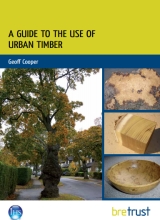A guide to the use of urban timber FB 50
BRE (Building Research Establishment) is an independent, research-based consultancy, testing and training organisation, operating in the built environment and associated industries.
A guide to the use of urban timber (FB 50) was written by Geoff Cooper and published by BRE on 31 July 2012.
Every day across the UK, thousands of tonnes of wood residue are produced through arboricultural work. However, the timber this produces is normally variable and inconsistent, resulting in problems with collection, transportation and selection. As a result, much of it is relegated to the much or firewood bin.
FB 50 is a 64-page illustrated guide to using timber from the UK’s urban timber resource, including street, park and urban woodland trees. It provides guidance on the selection and identification of high-value stems, as well as processing, drying, transport, storage and the logistical problems of dealing with felled material.
The guidance promotes the use of many common and exotic species for high-value solid wood products rather than being processed for firewood, chipped to produce mulch or sent to landfill. It is intended to help local authorities maximise the value of timber produced in towns and cities and to develop the best options for using solid wood produced during normal maintenance.
The contents of the guide are:
- Introduction.
- Material and species availability.
- Assessing stems for timber production.
- Value-added growth feature.
- A sawmill perspective.
- Timber dimensions, measurement and material grading.
- Wood drying.
- Air drying.
- The kiln drying of timber.
- Kiln drying processes.
- Drying schedules.
- Problems associated with wood drying.
- Calculating value.
- Identifying prospective markets.
- Appendix: Species list and wood property information.
- References.
[edit] Related articles on Designing Buildings Wiki
- 11 things you didn't know about wood.
- BRE articles on Designing Buildings Wiki.
- BRE Buzz articles on Designing Buildings Wiki.
- BRE Buzz.
- Building Research Establishment.
- Carpentry.
- Cat's paw figure.
- Definition of tree for planning purposes.
- Delivering sustainable low energy housing with softwood timber frame.
- Dunnage.
- End racking.
- Facts about forestry.
- Forest ownership.
- Forests.
- Physical Properties of Wood.
- Rip sawing.
- Ripple figure.
- Spalting.
- The differences between hardwood and softwood.
- Tiger-stripe figure.
- Timber preservation.
- Timber sticker.
- Timber vs wood.
- Timber.
- Tree preservation order.
- Tree rights.
- Types of timber.
- Urban trees.
- Waney edged.
Featured articles and news
Infrastructure that connect the physical and digital domains.
Harnessing robotics and AI in challenging environments
The key to nuclear decommissioning and fusion engineering.
BSRIA announces Lisa Ashworth as new CEO
Tasked with furthering BSRIA’s impressive growth ambitions.
Public buildings get half a million energy efficiency boost
£557 million to switch to cleaner heating and save on energy.
CIOB launches pre-election manifesto
Outlining potential future policies for the next government.
Grenfell Tower Inquiry announcement
Phase 2 hearings come to a close and the final report due in September.
Progress from Parts L, F and O: A whitepaper, one year on.
A replicated study to understand the opinion of practitioners.
ECA announces new president 2024
Electrical engineer and business leader Stuart Smith.
A distinct type of countryside that should be celebrated.
Should Part O be extended to existing buildings?
EAC brands heatwave adaptation a missed opportunity.
Definition of Statutory in workplace and facilities management
Established by IWFM, BESA, CIBSE and BSRIA.
Tackling the transition from traditional heating systems
59% lack the necessary information and confidence to switch.
The general election and the construction industry
As PM, Rishi Sunak announces July 4 date for an election.
Eco apprenticeships continue help grow green workforce
A year after being recognised at the King's coronation.
Permitted development rights for agricultural buildings
The changes coming into effect as of May 21, 2024.























